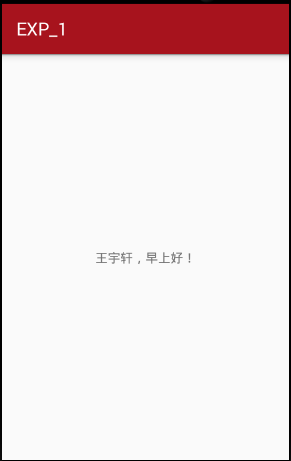實驗一 第一個Android程式和Activity生命週期
阿新 • • 發佈:2019-01-07
實驗一 第一個Android程式和Activity生命週期
實驗目的
生成執行第一個Android程式,熟悉瞭解Android手機開發平臺的基本構成和使用方法,熟悉Android應用程式專案的基本檔案目錄結構,瞭解開發環境提供的各種工具的基本用法。
在Activity中過載下9種事件函式,在呼叫不同函式時使用LogCat在Eclipse的控制檯中輸出呼叫日誌。掌握Activity在啟動、停止和銷燬等不同階段,9種過載函式的呼叫順序,並掌握Android除錯工具LogCat的使用方法
實驗要求
-
用工程嚮導生成第一個Android程式,並在模擬器上執行
注意在新建應用的選擇SDK版本時選API 18

-
熟悉Android應用程式的基本檔案結構
-
瞭解使用開發環境各種工具的基本用法
-
在程式中增加生命週期函式,並輸出log,可以參考課本的示例程式,根據logcat的輸出結果,分析程式的執行流程。注意分析以下幾種情況:
a. 程式正常啟動和關閉
b. 程式執行中,切換到其他程式
c. 程式執行中,有簡訊和電話呼入

工程程式碼
專案工程結構圖
activity_xml:
<?xml version= MainActivity:
package com.example.wyx.exp_1;
import android.support.v7.app.AppCompatActivity;
import android.os.Bundle;
import android.util.Log;
public class MainActivity extends AppCompatActivity {
private static String TAG = "LIFTCYCLE";
@Override //完全生命週期開始時被呼叫,初始化Activity
public void onCreate(Bundle savedInstanceState) {
super.onCreate(savedInstanceState);
setContentView(R.layout.activity_main);
Log.i(TAG, "(1) onCreate()");
}
@Override //可視生命週期開始時被呼叫,對使用者介面進行必要的更改
public void onStart() {
super.onStart();
Log.i(TAG, "(2) onStart()");
}
@Override //在onStart()後被呼叫,用於恢復onSaveInstanceState()儲存的使用者介面資訊
public void onRestoreInstanceState(Bundle savedInstanceState) {
super.onRestoreInstanceState(savedInstanceState);
Log.i(TAG, "(3) onRestoreInstanceState()");
}
@Override //在活動生命週期開始時被呼叫,恢復被onPause()停止的用於介面更新的資源
public void onResume() {
super.onResume();
Log.i(TAG, "(4) onResume()");
}
@Override // 在onResume()後被呼叫,儲存介面資訊
public void onSaveInstanceState(Bundle savedInstanceState) {
super.onSaveInstanceState(savedInstanceState);
Log.i(TAG, "(5) onSaveInstanceState()");
}
@Override //在重新進入可視生命週期前被呼叫,載入介面所需要的更改資訊
public void onRestart() {
super.onRestart();
Log.i(TAG, "(6) onRestart()");
}
@Override //在活動生命週期結束時被呼叫,用來儲存持久的資料或釋放佔用的資源
public void onPause() {
super.onPause();
Log.i(TAG, "(7) onPause()");
}
@Override //在可視生命週期結束時被呼叫,一般用來儲存持久的資料或釋放佔用的資源
public void onStop() {
super.onStop();
Log.i(TAG, "(8) onStop()");
}
@Override //在完全生命週期結束時被呼叫,釋放資源,包括執行緒、資料連線等
public void onDestroy() {
super.onDestroy();
Log.i(TAG, "(9) onDestroy()");
}
}
AndroidManifest:
<?xml version="1.0" encoding="utf-8"?>
<manifest xmlns:android="http://schemas.android.com/apk/res/android"
package="com.example.wyx.exp_1">
<application
android:allowBackup="true"
android:icon="@mipmap/ic_launcher"
android:label="@string/app_name"
android:roundIcon="@mipmap/ic_launcher_round"
android:supportsRtl="true"
android:theme="@style/AppTheme">
<activity android:name=".MainActivity">
<intent-filter>
<action android:name="android.intent.action.MAIN" />
<category android:name="android.intent.category.LAUNCHER" />
</intent-filter>
</activity>
</application>
</manifest>
實現效果


